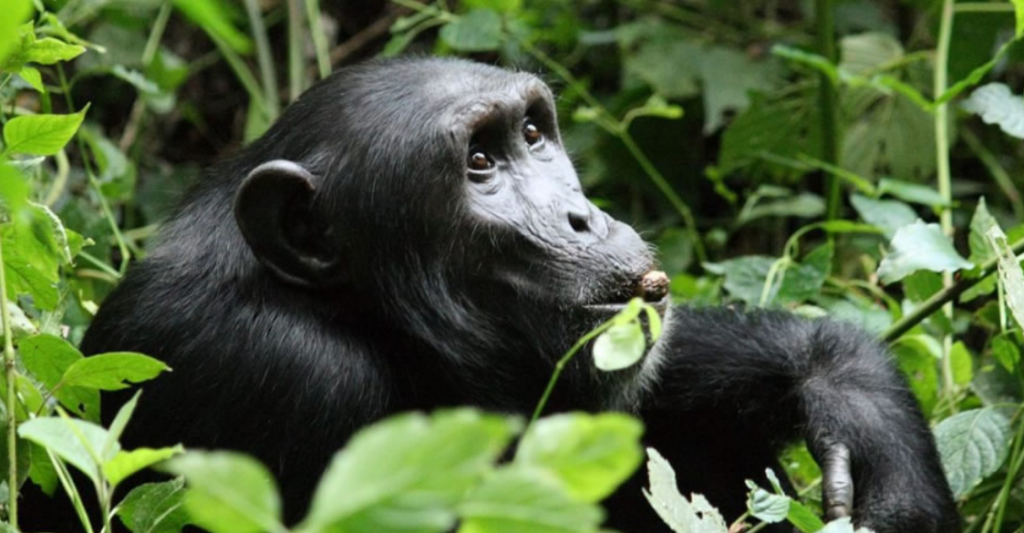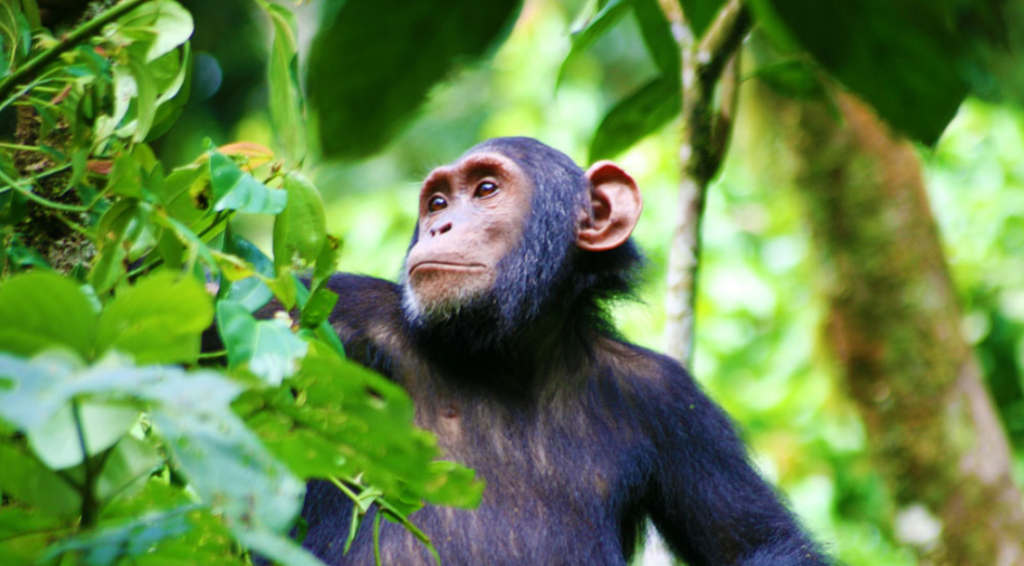Chimpanzee Trekking
Chimpanzee Trekking in Uganda
Chimpanzee trekking is one of the exciting activities to do in Uganda while on a wildlife safari to savanna parks in western Uganda that involves taking footsteps into rainforests searching for intelligent primates.
Chimpanzees are believed to have the closest DNA to humans with 98%. They are known to be extremely playful and keep on moving from one place to the next but note that they can also become aggressive once they are provoked. Adult chimpanzees weigh differently depending on the sex that is an average adult female chimpanzee can weigh between 30 to 50kgs at a height of 2 to 4 feet whereas a male adult chimpanzee weighs between 35 to 75 kgs at a height of 3 meters.
Chimpanzees relatively stay in groups of 10 to 100 with one dominant male as the leader. With their high intelligence, they can easily take care of each other like humans; hold hands, search for food, and care for the young ones. When a baby chimpanzee turns 4 years old, they tend to become independent and start looking for their food.
Chimpanzee tracking in Uganda gives you a magical hour watching the chimps feed, play, laugh, hug, kiss, and groom each other. The drama unfolds as male chimps hold fight bouts, slap hollow buttress roots, and chase each other, jostling for a seat at the top of the hierarchy.
Chimpanzee Behavior Patterns
Chimpanzees are highly social. They live on the ground in communities of several groups of animals but normally spend their time up in the tree canopies, especially at night and while feeding. They are led by an alpha male and his coalition of male allies and if another male wants to take over leadership, they have to fight for the position.
The male and female chimps have individual personalities, with females being more trusting and timid. Grooming is an important part of their social life, helping chimpanzees’ bond as they remove ticks and dirt from one another’s bodies.
Chimpanzees have long arms, hands, and fingers, which help them climb trees and swing from branch to branch. While on the ground, they use both hands and toes for walking (Knuckle walk) with half-flexed fingers due to their huge weight.
Habitat for chimps
Though many populations live in tropical rainforests, they can also be found in woodlands and grasslands spanning from central to western Africa. They usually sleep in trees—typically the sturdy Ugandan ironwood tree, which offers the most firm and stable place to sleep—and build themselves nests of leaves.
What do Chimpanzees feed on?
Chimps mainly feed on fruits and leaves. Though they generally prefer fruits and plants, they have a varied diet that also includes insects, eggs, nuts, and hundreds of other things. They relish meat and have been known to kill and eat monkeys, small antelope, and even tortoises which they slam against trees to break open their shells.

Recommended Safaris
Reproduction
Female chimpanzees can give birth at any time of year, typically to a single infant that clings to its mother’s fur and later rides her back until the time of weaning between ages three and five. Females reach reproductive age at 13, while males are not considered adults until they are 15.
Where to go for chimpanzee trekking in Uganda?
There are several destinations in Uganda where to go tracking chimpanzees, the main destination is Kibale National Park “the primate capital of the world” and other destinations include Budongo forest in Murchison Falls, Kyambura Gorge in Queen Elizabeth National Park, Semuliki Wildlife Reserve, and Kalinzu forest.
Chimpanzee Trekking in Kibale National Park
Kibale National Park is the main chimpanzee destination with the largest number of chimpanzees with about 1500 chimpanzees 120 of which are habituated. The chimpanzees are trekked twice a day i.e. in the morning and the afternoon. Besides meeting the chimpanzees, the park is a paradise to other primates such as Bush babies, monkeys like the colobus monkeys, red-tailed monkeys, a wide variety of bird species (400), and other forest wildlife like giant forest hogs and forest elephants.

Chimp Tracking in Kibale Forest
Chimpanzee trekking in Kibale National Park starts from Kanyanchu Visitor Center at 8:00 am and lasts 2-3 hours. The Primates are searched down by visitors during the tracking. These include black & white Colobus, grey-cheeked Mangabey, and red-tailed monkey. Your guides will show you pittas along with other bird species & will explain the tradition of different plant species within the forest. This walk is for 6 individuals per tour group.



Chimpanzee treks permit in Kibale costs USD 250. Chimpanzee habituation is also done at the Kibale National Park at USD 300 and this is where visitors get to spend more time with the primates for example 6 hours or the whole day.
Kyambura Gorge in Queen Elizabeth National Park
It’s located in the eastern part of Queen Elizabeth National Park in southwestern Uganda, the gorge is a haven for chimps and other primates as well as colorful bird species.
The 1-km-long and 300-ft-deep “Valley of The Apes” gorge is surrounded by the magnificent vast savannah plains, rift valley craters, and the Rwenzori Mountains as a brooding backdrop to the incredible scenery.

Trekking chimps down the ravine’s steep slopes, through the vines and giant fig trees (less conventional than tiring), will make you feel like you’re in an underground forest.
You’ll be hopping over streams and traversing rivers as you seek out the chimpanzee troop; once you find them, you can spend a superb hour watching them feed, interact, play, and go about their daily basic chores.

Other Suggested Packages
8 Days Murchison Falls, Gorilla, Chimpanzee & Queen Elizabeth Safari
$ 1790
per personChimpanzee Trekking in the Ngamba Island Chimpanzee Sanctuary
Ngamba Island is located on Lake Victoria and easily accessed by a speedboat from Entebbe is one of the places where you can enjoy chimpanzee trekking while in Uganda.
The Island part where the chimpanzees are kept is fenced off to allow the chimps to roam freely without causing damage to the neighbors. The speedboat that goes to Ngamba has two shifts with a half trip starting in the morning and a full one starting at 5 pm.
The sanctuary started with about 13 chimpanzees that were rescued by a few locals and ever since the number of chimpanzees has grown to over 50 chimpanzees that have either been rescued or orphaned. You get to see the chimpanzees at different stages, get in close contact with them, and also carry out other activities like fishing, swimming, exploring the villages, and birding.
Chimpanzee Trekking in the Murchison Falls National Park
Murchison Falls National Park is home to numerous forests, these are the Budongo forest, the Kaniyo Pabidi, and the Rabongo forest where chimpanzee trekking takes place.
These three forests have over 600 chimpanzees making Murchison a good destination for chimpanzee trekking. Murchison National Park is home to over 500 bird species, and wildlife and is a top destination for many tourists who come to Uganda for safaris.
The Rabongo forest is also a forest found within the Murchison and where trekking is carried out. You will take bush walks with park rangers and set out within the forest in search of the chimpanzees which when found, you will get an hour with them as they scamper from one tree to another.
Budongo forest, Budongo forest is a top destination for chimpanzee trekking and has a large number of primates. On guided nature walks in the forest with park rangers, trekking will be easy and you get to see other primates like monkeys, olive baboons, and red-tailed monkeys, and do birding among other activities.
Kaniyo Pabidi forest, a home to chimpanzees, a wide range of bird species, insects, and other primates, the forest is one of the few in the country that has remained in its natural state without any tampering from humans.
Best time to go for Chimpanzee trekking in Uganda.
Chimpanzee trekking in Uganda can be done throughout the year however the best time to track chimps is during the dry season June to September and December to January. During the dry season, the trek trails are passable, the vegetation is clear, and it is also easier to see the chimpanzees unlike during the rainy season when the roads and trails become slippery, and the vegetation is dense making chimp sighting hard.
In conclusion
Chimpanzee Trekking in Uganda’s tropical rainforests promises dramatic encounters with one of the most fascinating great apes to walk this planet.
Don’t wait,
book this adventure safari today
Low season
Oct, Nov, Mar, Apr, may
Peak season
Jun, July, Aug, Sept, Dec

Got any questions
about traveling to Uganda?
Get in touch.



